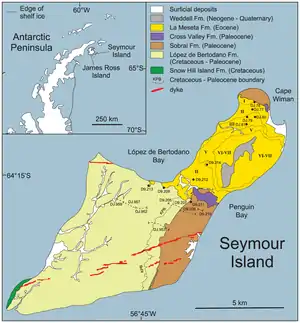La Meseta Formation
The La Meseta Formation is a sedimentary sequence deposited during the Eocene.[2] The formation is found on Seymour Island, Antarctica.
| La Meseta Formation Stratigraphic range: Eocene | |
|---|---|
| Type | Geological formation |
| Unit of | Seymour Island Group[1] |
| Underlies | Weddell Formation |
| Overlies | Lopez de Bertodano, Sobral & Cross Valley Formations |
| Thickness | 557 m (1,827 ft)[2] |
| Lithology | |
| Primary | Sandstone, claystone |
| Other | Siltstone, mudstone, conglomerate |
| Location | |
| Coordinates | 64°14′21.782″S 56°36′11.69″W.[3] |
| Approximate paleocoordinates | 63.7°S 61.5°W |
| Region | Seymour Island |
| Country | Antarctica |
 Geologic map of Seymour Island, Antarctica with La Meseta Formation in dark yellow | |
Description
La Meseta Formation lies unconformably on the Cretaceous Lopez de Bertodano Formation. It is an approximately 557 metres (1,827 ft) thick sequence of poorly consolidated sandstones and siltstones. The depositional environment was probably coastal, deltaic or estuarine in character. The top of the sequence is an erosional unconformity to Pleistocene glacial gravels.[3][2] La Meseta Formation is one of the sequences that make up the fill of the Late Jurassic to Paleogene James Ross Basin.[3]
Fossil content
La Meseta Formation is extremely rich in fossils. Among mammals, the meridiungulata Antarctodon and Trigonostylops have been found in the formation.[4][5] as well as marsupial Microbiotheria.[6] It is famous for its penguin fossils, for example the two genera Archaeospheniscus and Palaeeudyptes. Other bird fossils include Dasornis, a genus of pseudotooth birds. There are also an abundance of trace fossils. Diplocraterion, Helminthopsis, Muensteria, Oichnus, Ophiomorpha, Skolithos, Teredolites and Zapfella have been described.[7] Over 35 species and 26 families of fish have been described from the Ypresian Cucullaea bed.[3]
Mammals
- Antarctodon
- Antarctodolops
- Llanocetus
- Basilosaurus
- Derorhynchus
- Notolophus arquinotiensis
- Marambiotherium glacialis
- Woodburnodon casei
- Victorlemoinea
- Trigonostylopidae indet.
References
- Zinsmeister, Jeffrey D. Stilwell ; William J. (1992). Molluscan systematics and biostratigraphy : Lower Tertiary La Meseta Formation, Seymour Island, Antarctic Peninsula. Washington, DC: American Geophysical Union. ISBN 978-0875907703.
- Pezzetti, T.F.; KRISSEK, L.A (1986). "Re-evaluation of the Eocene La Meseta Formation of Seymour Island, AntarcticPeninsula": 75. Cite journal requires
|journal=(help) - Reguero, Marcelo A.; Sergio A. Marenssi; Sergio N. Santillana (2012). "Weddellian marine/coastal vertebrates diversity from a basal horizon (Ypresian, Eocene) of the Cucullaea I Allomember, La Meseta formation, Seymour (Marambio) Island, Antarctica". Rev. Peru. Biol. 19: 275–284.
- Antarctodon at Fossilworks.org
- Trigonostylops at Fossilworks.org
- Goin, F. J.; Zimicz, N.; Reguero, M. A.; Santillana, S. N.; Marenssi, S. A.; Moly, J. J. (October 2007). "New marsupial (Mammalia) from the Eocene of Antarctica, and the origins and affinities of the Microbiotheria". Revista de la Asociación Geológica Argentina. 62 (4): 597–603. ISSN 1851-8249. Retrieved 2017-02-12.
- Uchman, Alfred; Andrzej GAŹDZICKI (2006). "New trace fossils from the La Meseta Formation (Eocene) of Seymour Island, Antarctica". Pol. Polar Res. 27: 153–170.
Further reading
- R. A. Askin. 1997. Eocene-?Earliest Oligocene terrestrial palynology of Seymour Island, Antarctica. : 993-996. The Antarctic Region: Geological Evolution and Processes 993-996
- M. A. Bitner. 1991. A supposedly new brachiopod from the Paleogene of Seymour Island, West Antarctica. Polish Polar Research 12(2):243-246
- D. B. Blake and R. B. Aronson. 1998. Eocene stelleroids (Echinodermata) at Seymour Island, Antarctic Peninsula. Journal of Paleontology 72(2):339-353
- M. Bond, M. A. Reguero, S. F. Vizcaino and S. A. Marenssi. 2006. A new 'South American ungulate' (Mammalia: Litopterna) from the Eocene of the Antarctic Peninsula. Geological Society, London, Special Publications 258:163-176
- J. A. Case. 1988. Paleogene floras from Seymour Island, Antarctic Peninsula. Geology and Paleontology of Seymour Island Antarctic Peninsula 523-540
- M. M. Cenizo. 2012. Review of the putative Phorusrhacidae from the Cretaceous and Paleogene of Antarctica: new records of ratites and pelagornithid birds. Polish Polar Research 33(3):225-244
- A. L. Cione, M. de las Mercedes Azpelicueta, and D. R. Bellwood. 1995. An oplegnathid fish from the Eocene of Antarctica. Palaeontology 37(4):931-940
- A. L. Cione and M. A. Reguero. 1994. New records of the sharks Isurus and Hexanchus from the Eocene of Seymour Island, Antarctica. Proceedings of the Geologists' Association 105:1-14
- J. Kriwet. 2005. Additions to the Eocene Selachian Fauna of Antarctica with Comments on Antarctic Selachian Diversity. Journal of Vertebrate Paleontology 25(1):1-7
- S. A. Marenssi, M. A. Regeuro, S. N. Santillana and S. F. Vizcaino. 1994. Eocene land mammals from Seymour Island, Antarctica: palaeobiogeographical implications. 6(1):3-15
- I. Poole, A. M. W. Mennega, and D. J. Cantrill. 2003. Valdivian ecosystems in the Late Cretaceous and Early Tertiary of Antarctica: further evidence from myrtaceous and eucryphiaceous fossil wood. Review of Palaeobotany and Palynology 124:9-27
- R. R. Pujana, S. N. Santillana, and S. A. Marenssi. 2014. Conifer fossil woods from the La Meseta Formation (Eocene of Western Antarctica): Evidence of Podocarpaceae-dominated forests. Review of Palaeobotany and Palynology (200)122-137
- S. F. Vizcaino, M. A. Reguero, S. A. Marenssi and S. N. Santillana. 1997. New land mammal-bearing localities from the Eocene La Meseta Formation, Seymour Island, Antarctica. The Antarctic Region: Geological Evolution and Processes 997-1000
